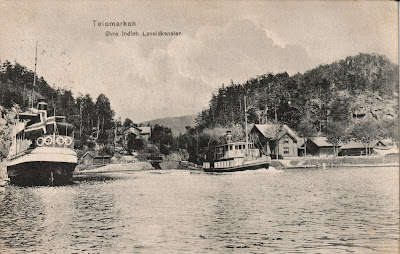“Five Graces” Bandwagon, Barnum & Bailey Circus
The Russell News Agency, Inc. distributed this color postcard
that features what was known as the Five Graces Bandwagon used by the Barnum
& Bailey Circus in parades between 1898 and 1902. The number 51475 appears at the bottom center
on the reverse. There is a blurb at the
top left corner: “Ringling Museum of the
Circus, Sarasota, Florida. Glorious
reminder of the “Golden Age” of American circus is the “Five Graces” Bandwagon. The oldest, built in 1878, and most widely
traveled circus parade vehicle in existence.
The bandwagon, drawn by 40 black horses, led the Barnum and Bailey
European parades from 1898-1902. This
wagon is thought to have been built for Adam Forepaugh’s circus and later
acquired by P.T. Barnum.
In the early days of the circus, around the 1870s, wagons
were used to haul all the animals and equipment from town to town. The wagons were costly to build and weighed
approximately 8 tons, requiring 40 horses to pull each wagon. The wagons were also used in the parades
through the towns before the big tent was set up and the shows began. P.T. Barnum coined the phrase “The Greatest
Show on Earth,” and advertised his circus as a Great Traveling Museum,
Menagerie, Caravan, and Hippodrome. The
wagons carried people, animals, and equipment, such as tents, props, costumes,
luggage, musical instruments, food supplies, etc. One wagon
even had a separate glass cage for the snakes.
Forepaugh’s Circus and P.T. Barnum’s Circus were the two
largest circuses in the United States during the 1870 and 1880s. In addition, there were several smaller
circuses in the 1800s that eventually went bust or were merged into one of the
larger ones. Forepaugh died in 1890 and
his circus joined with Sells Brothers in 1900.
In 1907 the seven Ringling Brothers purchased Barnum and Bailey. Transition to the much faster and more
efficient rail travel began in the 1890s; although, the wagons were still used
in parades.
The Five Graces Wagon is the oldest surviving example of the
circus wagons of that era. In the 1940s
it was fitted out with modern gears and modern tires and appeared in a war bond
parade in New York City. From 1946 to
1948 it was in storage. Eventually,
in 1959, it was moved to the Museum of the American Circus located on the
grounds of the John Ringling estate in Sarasota, Florida, where the original
style of wheels replaced the upgraded ones, red paint and gold leaf finished
the restoration as shown on the card.
For additional information, see:
https://en.wikipedia.org/wiki/Ringling_Bros._and_Barnum_%26_Bailey_Circus
http://circusnospin.blogspot.com/2011/09/five-graces-bandwagon-has-new-home.html
https://www.facebook.com/TheRingling/posts/objectoftheweek-at-theringling-the-five-graces-bandwagon-is-one-of-the-oldest-an/10156088240093989/
https://en.wikipedia.org/Adam_Forepaugh


